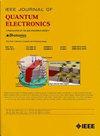Gain and Threshold Improvements of 1300 nm Lasers Based on InGaAs/InAlGaAs Superlattice Active Regions
IF 2.2
3区 工程技术
Q3 ENGINEERING, ELECTRICAL & ELECTRONIC
引用次数: 0
Abstract
A detailed experimental analysis of the impact of active region design on the performance of 1300 nm lasers based on InGaAs/InAlGaAs superlattices is presented. Three different types of superlattice active regions and waveguide layer compositions were grown. Using a superlattice allows to downshift the energy position of the miniband, as compared to thin InGaAs quantum wells, having the same composition, being beneficial for high-temperature operation. Very low internal loss (~6 cm−1), low transparency current density of ~500 A/cm2, together with 46 cm−1 modal gain and 53 % internal efficiency were observed for broad-area lasers with an active region based on a highly strained In0.74Ga0.26As/In0.53Al0.25Ga0.22As superlattice. Characteristic temperatures基于 InGaAs/InAlGaAs 超晶格有源区的 1300 nm 激光器的增益和阈值改进
实验分析了有源区设计对基于InGaAs/InAlGaAs超晶格的1300 nm激光器性能的影响。生长了三种不同类型的超晶格有源区和波导层组成。与具有相同成分的薄InGaAs量子阱相比,使用超晶格可以降低微带的能量位置,有利于高温操作。对于基于高应变In0.74Ga0.26As/In0.53Al0.25Ga0.22As超晶格的广域激光器,可以观察到非常低的内部损耗(~6 cm−1)、~500 A/cm2的低透明电流密度、46 cm−1模态增益和53%的内部效率。特征温度$T_{0}$和$T_{1}$分别提高到76 K和100 K。这些数据表明,这种超晶格也有可能大大改善该波长的VCSEL特性。
本文章由计算机程序翻译,如有差异,请以英文原文为准。
求助全文
约1分钟内获得全文
求助全文
来源期刊

IEEE Journal of Quantum Electronics
工程技术-工程:电子与电气
CiteScore
4.70
自引率
4.00%
发文量
99
审稿时长
3.0 months
期刊介绍:
The IEEE Journal of Quantum Electronics is dedicated to the publication of manuscripts reporting novel experimental or theoretical results in the broad field of the science and technology of quantum electronics. The Journal comprises original contributions, both regular papers and letters, describing significant advances in the understanding of quantum electronics phenomena or the demonstration of new devices, systems, or applications. Manuscripts reporting new developments in systems and applications must emphasize quantum electronics principles or devices. The scope of JQE encompasses the generation, propagation, detection, and application of coherent electromagnetic radiation having wavelengths below one millimeter (i.e., in the submillimeter, infrared, visible, ultraviolet, etc., regions). Whether the focus of a manuscript is a quantum-electronic device or phenomenon, the critical factor in the editorial review of a manuscript is the potential impact of the results presented on continuing research in the field or on advancing the technological base of quantum electronics.
 求助内容:
求助内容: 应助结果提醒方式:
应助结果提醒方式:


